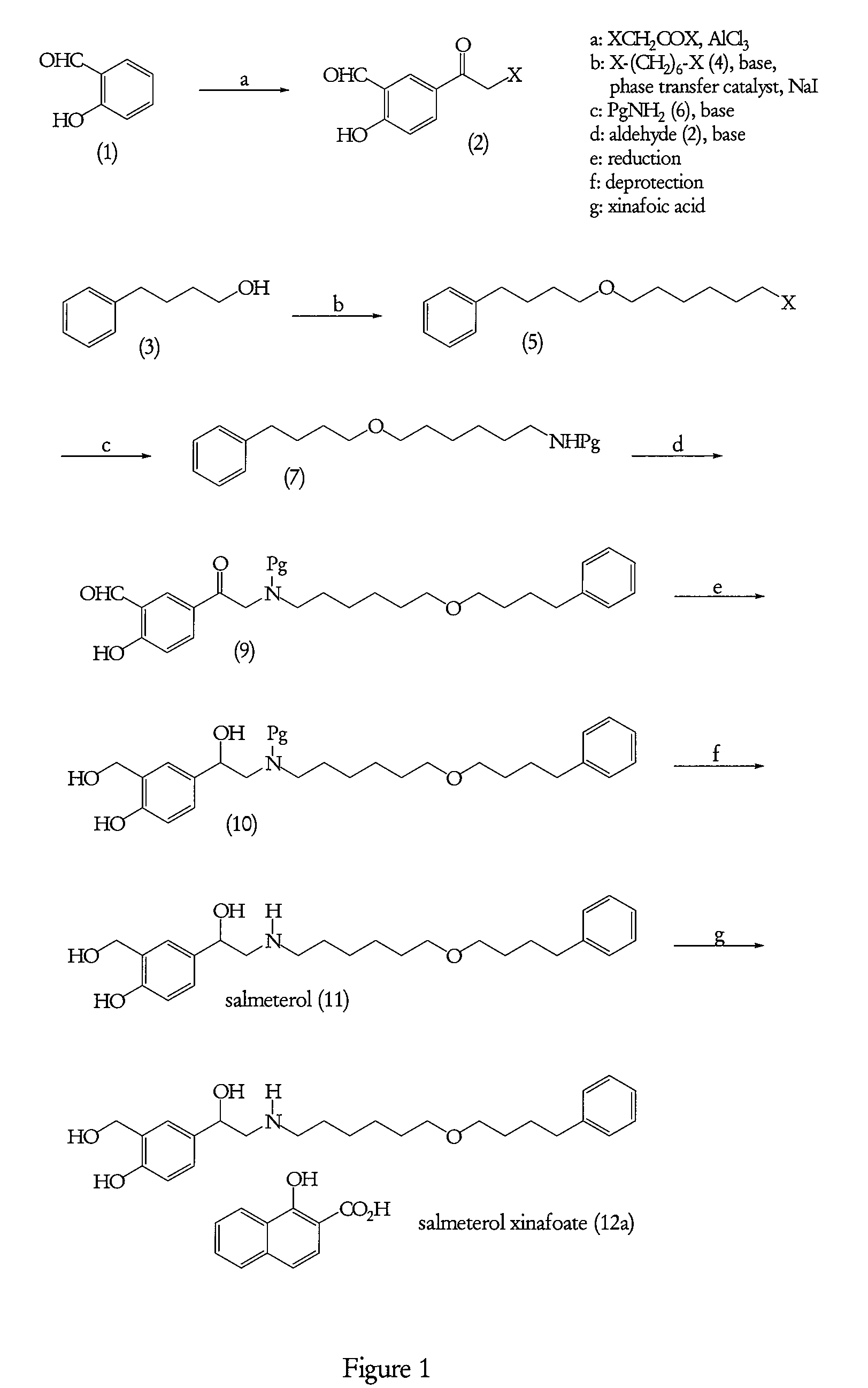Novel process
a technology of a new process, applied in the field of new process, can solve the problems of insufficient purity, severe quality disadvantages, and inability to meet the requirements of commercial manufacturing processes, and achieve the effect of removing cumbersome purification techniques
- Summary
- Abstract
- Description
- Claims
- Application Information
AI Technical Summary
Benefits of technology
Problems solved by technology
Method used
Image
Examples
example 1
Preparation of 5-(Bromoacetyl)-2-hydroxybenzaldehyde (2a)
[0115](Synthetic Communications, vol. 29(12a), pages 2155-2162, 1999; and U.S. Pat. No. 5,011,993)
[0116]To a suspension of aluminium chloride (4 m / m) in dichloromethane (10 volumes), was added slowly bromoacetyl bromide (1.2 m / m) at 10° C. and then the temperature was brought to 30° C. The reaction mass was stirred at this temperature for an hour and to this was added a solution of 2-hydroxybenzaldehyde (1) in dichloromethane at 30° C. The reaction mixture was stirred at 35-40° C. for 12-15 hours and then quenched in water at 0-5° C. The dichloromethane layer was separated and distilled off. To the slurry obtained, n-heptane was added and stirred for 15 minutes. This slurry was then filtered and the wet cake was washed with n-heptane (2 volumes). The wet cake was dried at 50° C. to constant weight to obtain intermediate (2a).
[0117]Yield: 55% w / w
[0118]HPLC purity: 97-99%
example 2
Preparation of Bromoether (5a)
[0119]To a suspension of sodium hydride (0.9 m / m) in toluene, 4-phenyl-1-butanol (3) (1.0 m / m) was added at 25-30° C. followed by addition of 1,6-dibromohexane (4a) (1.2 m / m), sodium iodide and tetrabutyl ammonium bromide in catalytic amounts. The reaction mixture was stirred at 45-50° C. under a nitrogen gas atmosphere for 15-20 hours. The reaction mixture was quenched with water. The toluene layer was washed by water and the solvent was distilled off under reduced pressure to obtain a light yellow coloured liquid. The crude product bromoether (5a) thus obtained was used as such for the preparation of N-[6-(4-phenylbutoxy)hexyl]benzenemethanamine as described below.
example 3
Preparation of N-[6-(4-phenylbutoxy)hexyl]benzenemethanamine hydrochloride (8b)
[0120]A mixture of benzylamine (6a) (3 m / m), triethylamine (2 m / m), and sodium iodide in catalytic amount in acetonitrile was heated to 45-50° C. under stirring. To this, bromoether (5a) was added slowly at the said temperature and the reaction was continued until TLC monitoring showed disappearance of bromoether intermediate (5a). Then solvent, excess benzylamine (6a) and triethylamine were distilled off under reduced pressure. To the crude mass obtained was added water and extracted with dichloromethane. The dichloromethane layer was washed with water liberally. This isolated dichloromethane layer was treated with 5M HCl. The dichloromethane layer was again washed with water and the solvent was distilled off until a syrupy mass was obtained. This syrupy mass was added to n-heptane (8 volumes) under stirring. The solid product thus obtained was filtered off. This was dissolved in isopropanol (3 volumes) ...
PUM
| Property | Measurement | Unit |
|---|---|---|
| temperature | aaaaa | aaaaa |
| temperature | aaaaa | aaaaa |
| temperature | aaaaa | aaaaa |
Abstract
Description
Claims
Application Information
 Login to View More
Login to View More - R&D
- Intellectual Property
- Life Sciences
- Materials
- Tech Scout
- Unparalleled Data Quality
- Higher Quality Content
- 60% Fewer Hallucinations
Browse by: Latest US Patents, China's latest patents, Technical Efficacy Thesaurus, Application Domain, Technology Topic, Popular Technical Reports.
© 2025 PatSnap. All rights reserved.Legal|Privacy policy|Modern Slavery Act Transparency Statement|Sitemap|About US| Contact US: help@patsnap.com



